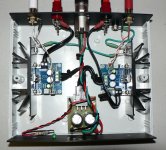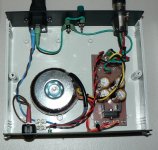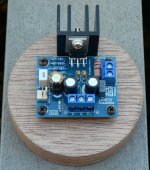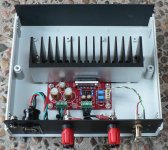Is that ground from the transformer or ground post-PSU?
Do you have a link to the ESP-page?
The resistor diode network sits between the power supply ground output (after rectification and caps) and the safety chassis earth. In the link below imagine the 2 ground symbols are joined.
Power Supply for Power Amplifiers
Hi
because my planning into my housing gets to the final step i realized that i miss the protection/soft start board... .. to avoid pop on/offf in the speakers. Any suggestions/experiences?
.. to avoid pop on/offf in the speakers. Any suggestions/experiences?
this?
AIYIMA UPC1237 2.0 Speaker Protection Board kit Parts reliable performance for HIFI Amplifier DIY-in Amplifier from Consumer Electronics on Aliexpress.com | Alibaba Group
chris
because my planning into my housing gets to the final step i realized that i miss the protection/soft start board...
this?
AIYIMA UPC1237 2.0 Speaker Protection Board kit Parts reliable performance for HIFI Amplifier DIY-in Amplifier from Consumer Electronics on Aliexpress.com | Alibaba Group
chris
Kit amp section build
I finally received my replacement kits after the original was damaged in transport.
Nothing fancy with the build and went with the ESP Project 72 values except for the 1M resistor to ground and linked the 10R resistor. Couldn't fit the Nichicon ES 47uF feedback cap so used a Nichicon ES 22uF as per the TI datasheet. Didn't use any of the kit parts and all resistors and caps measured and matched.
Heatsinks are 2.5°C/W for each module and under test with a 4 ohm speaker remained lukewarm. Did have a small pop at turn off and I think it is the additional power supply caps in the amp case discharging so I will remove them. Installed wiring for heatsink grounding but didn't need to link back to the power supply ground / earth.
First power supply with 50VA 18-0-18 transformer:
± 27.8VDC power supply only not loaded
± 26.95VDC with amp connected
± 25.5 to 26.5VDC loaded with music playing
DC offset -1.7mV L -1.7mV R
Second power supply with 20VA 15-0-15 transformer:
± 23.17VDC power supply only not loaded
± 21.8VDC with amp connected
± 19 to 21.5VDC loaded with music playing
DC offest -1.4mV L -1.4mV R
From this the 20VA transformer is on the limit but came close to bottoming out the 4 ohm speakers. 50VA would be a better choice.
For parts I used:
1% MF resistors and Panasonic for the 2R7 zobel (3mm gap off the board)
Input cap 2.2uF MMK (Kemet)
By pass monolithic TDK X7R
Feedback cap Nichicon ES
Power caps Nichicon KA
Zobel cap 100V MKT
Wakefield-Vette 173-9-230P insulators for the LM1875T to heatsink
The 21VDC power supply used a 20VA 15-0-15 > 6A BR > 4 x 2200uF caps. Fuses 0.5A SB (for 240VAC supply) and 1.25A for DC output. The 25VDC power supply was detailed earlier in the thread.
Sounds quite good with no background hiss, noise, hum etc. Early days as run for only 1 hour so will give some more impressions in a few days.
I finally received my replacement kits after the original was damaged in transport.
Nothing fancy with the build and went with the ESP Project 72 values except for the 1M resistor to ground and linked the 10R resistor. Couldn't fit the Nichicon ES 47uF feedback cap so used a Nichicon ES 22uF as per the TI datasheet. Didn't use any of the kit parts and all resistors and caps measured and matched.
Heatsinks are 2.5°C/W for each module and under test with a 4 ohm speaker remained lukewarm. Did have a small pop at turn off and I think it is the additional power supply caps in the amp case discharging so I will remove them. Installed wiring for heatsink grounding but didn't need to link back to the power supply ground / earth.
First power supply with 50VA 18-0-18 transformer:
± 27.8VDC power supply only not loaded
± 26.95VDC with amp connected
± 25.5 to 26.5VDC loaded with music playing
DC offset -1.7mV L -1.7mV R
Second power supply with 20VA 15-0-15 transformer:
± 23.17VDC power supply only not loaded
± 21.8VDC with amp connected
± 19 to 21.5VDC loaded with music playing
DC offest -1.4mV L -1.4mV R
From this the 20VA transformer is on the limit but came close to bottoming out the 4 ohm speakers. 50VA would be a better choice.
For parts I used:
1% MF resistors and Panasonic for the 2R7 zobel (3mm gap off the board)
Input cap 2.2uF MMK (Kemet)
By pass monolithic TDK X7R
Feedback cap Nichicon ES
Power caps Nichicon KA
Zobel cap 100V MKT
Wakefield-Vette 173-9-230P insulators for the LM1875T to heatsink
The 21VDC power supply used a 20VA 15-0-15 > 6A BR > 4 x 2200uF caps. Fuses 0.5A SB (for 240VAC supply) and 1.25A for DC output. The 25VDC power supply was detailed earlier in the thread.
Sounds quite good with no background hiss, noise, hum etc. Early days as run for only 1 hour so will give some more impressions in a few days.
Attachments
Last edited:
Hi
because my planning into my housing gets to the final step i realized that i miss the protection/soft start board..... to avoid pop on/offf in the speakers. Any suggestions/experiences?
Usually not required on ChipAmps and with transformers under 300VA. Sure I have a power off pop but is of my own doing with the additional power supply caps.
Never needed one in all my other solid state amps either.
It was recommended at the ESP construction articles when using an external power supply but I don't think it's necessary. When I bench test amps, I have long wires and clips all over the place and doesn't seem to hurt performance but may be able to be measured.
I'm going to remove them.
I'm going to remove them.
Usually not required on ChipAmps and with transformers under 300VA. Sure I have a power off pop but is of my own doing with the additional power supply caps.
Never needed one in all my other solid state amps either.
Thanks rabbitz for your experience.
+
nice amp and psu ! thanks for sharing that! which connect are you using for psu transfer? xlr?
chris
Yes an XLR AC3M. Supposed to be good for 15A and up to 50V for domestic use.
thx
Paperweight
Made a paperweight out of one of the shipping damaged boards. Made the PCB flat again and joined the splits. Mounted on a plywood loudspeaker driver cutout.
Used the chip that was supplied on the replacement kit and used components that I had laying around.
Yes, it does work and has a DC offset of 5mV. Heatsink only gets lukewarm at idle but does get quite warm after one song. Sounds quite good and unlike my other build, there is no pop on shutdown (when caps are drained).... go figure.
Made a paperweight out of one of the shipping damaged boards. Made the PCB flat again and joined the splits. Mounted on a plywood loudspeaker driver cutout.
Used the chip that was supplied on the replacement kit and used components that I had laying around.
Yes, it does work and has a DC offset of 5mV. Heatsink only gets lukewarm at idle but does get quite warm after one song. Sounds quite good and unlike my other build, there is no pop on shutdown (when caps are drained).... go figure.
Attachments
2 cents worth
This LM1875 module is a great kit for the beginner as it sounds quite good and is easy to build. I still would throw away the parts and use the PCB as the layout is quite good and being single sided, makes rework easier for a beginner.
OK for a computer or small room but most of the cost is in the power supply, case, heatsink and transformer. I still feel you are better off building a LM3886 or LM3875 as you will get much better performance for the extra dollars. Good examples I've built are ESP P19, Neurochrome 3886DR and for the Gainclone experience, Audiosector LM3875.
If a cheap and simple amp is required I'd go for a TPA3116D2 as all you need for power is a DC wall wart or DC brick so there are no dangerous AC voltages to work with. Just need to find one without hiss and the only one I found is the so called blue/black TPA3116D2 Danzz design. All the ones I've tried with a pot had hiss at some pot position. I also have a soft spot for the Dayton DTA-2 (Tripath TA2024) which I use on my computer. I've removed the volume pot so it works as a little power amp in conjunction with a Dragonfly.
For those who want to move beyond Chipamps, the best I've built are from Aspen Amplifiers (AKSA... Hugh Dean), Holton Precision Audio (Anthony Holton), ESP (Rod Elliott). I've built others but my preference were from these designers. However, these days most are supplied as modules or completed amps now instead of kits in the past when I built them.
Of course there are heaps of other designs (Nelson Pass etc) out there but I have no experience with them.
Finally, to compare the LM1875, I had a unused LM4780 module here which I threw into a case and used the same power supply. The LM4780 was smoother, had more body and control but the LM1875 is no slouch and held up well plus a bit more forward. This LM4780 module that had some issues was about US$10 more expensive plus I had to change out inferior and incorrect value caps.
End of rant.
This LM1875 module is a great kit for the beginner as it sounds quite good and is easy to build. I still would throw away the parts and use the PCB as the layout is quite good and being single sided, makes rework easier for a beginner.
OK for a computer or small room but most of the cost is in the power supply, case, heatsink and transformer. I still feel you are better off building a LM3886 or LM3875 as you will get much better performance for the extra dollars. Good examples I've built are ESP P19, Neurochrome 3886DR and for the Gainclone experience, Audiosector LM3875.
If a cheap and simple amp is required I'd go for a TPA3116D2 as all you need for power is a DC wall wart or DC brick so there are no dangerous AC voltages to work with. Just need to find one without hiss and the only one I found is the so called blue/black TPA3116D2 Danzz design. All the ones I've tried with a pot had hiss at some pot position. I also have a soft spot for the Dayton DTA-2 (Tripath TA2024) which I use on my computer. I've removed the volume pot so it works as a little power amp in conjunction with a Dragonfly.
For those who want to move beyond Chipamps, the best I've built are from Aspen Amplifiers (AKSA... Hugh Dean), Holton Precision Audio (Anthony Holton), ESP (Rod Elliott). I've built others but my preference were from these designers. However, these days most are supplied as modules or completed amps now instead of kits in the past when I built them.
Of course there are heaps of other designs (Nelson Pass etc) out there but I have no experience with them.
Finally, to compare the LM1875, I had a unused LM4780 module here which I threw into a case and used the same power supply. The LM4780 was smoother, had more body and control but the LM1875 is no slouch and held up well plus a bit more forward. This LM4780 module that had some issues was about US$10 more expensive plus I had to change out inferior and incorrect value caps.
End of rant.
Attachments
Thanks rabbitz for sharing your experience..
i re checked the housing and other parts:
at Aliexpress - -"my" preferred housing cost about 47 € with shipping.
Douk Audio Amplifier Chassis General Aluminum Shell Pre Amp Enclosure DIY Box-in Amplifier from Consumer Electronics on Aliexpress.com | Alibaba Group
the other housing - Galaxy Maggiorato GX288 230 x 280 mm + delivery cost me 34 euro +
i have to buy a power socket with fuse with 4,4 euro +
%product-title% kaufen
i have to buy 2 x 2,5 C/W heatsink with about 2x5,5 euros..... - max high 50mm.
%product-title% kaufen
.so the price is nearly the same for me.
the 50VA is about 26 euro- 80VAis 33 €
the 120VA transformer. cost 35 €
-->......the housing and the 120VA/2x18V is ordered
chris
i re checked the housing and other parts:
at Aliexpress - -"my" preferred housing cost about 47 € with shipping.
Douk Audio Amplifier Chassis General Aluminum Shell Pre Amp Enclosure DIY Box-in Amplifier from Consumer Electronics on Aliexpress.com | Alibaba Group
the other housing - Galaxy Maggiorato GX288 230 x 280 mm + delivery cost me 34 euro +
i have to buy a power socket with fuse with 4,4 euro +
%product-title% kaufen
i have to buy 2 x 2,5 C/W heatsink with about 2x5,5 euros..... - max high 50mm.
%product-title% kaufen
.so the price is nearly the same for me.
the 50VA is about 26 euro- 80VAis 33 €
the 120VA transformer. cost 35 €
-->......the housing and the 120VA/2x18V is ordered
chris
Hi rabbitz thank for your Class D hints..
but i did...some journey in Class D
https://www.diyaudio.com/forums/cla...tpa3116-2-0-100w-dual-chip-2.html#post5790490
https://www.diyaudio.com/forums/class-d/315681-tpa3250-listening-74.html#post5652627
https://www.diyaudio.com/forums/class-d/309813-wrong-tpa3255-77.html#post5701127
i am saturated with class D -


chris
but i did...some journey in Class D
https://www.diyaudio.com/forums/cla...tpa3116-2-0-100w-dual-chip-2.html#post5790490
https://www.diyaudio.com/forums/class-d/315681-tpa3250-listening-74.html#post5652627
https://www.diyaudio.com/forums/class-d/309813-wrong-tpa3255-77.html#post5701127
i am saturated with class D -
chris
I have done a test with the "LM1875" that comes in the kit.
My Psu is regulated at +/-16Vdc (It has no voltage drops) and I have obtained 11,35Vac@1,40A* on the output. If my calculations are correct, this is around 15,8Watts@8Ohm*
*Input signal 1vRms@1Khz.
These results are more in line with the technical characteristics of the TDA2030.
My Psu is regulated at +/-16Vdc (It has no voltage drops) and I have obtained 11,35Vac@1,40A* on the output. If my calculations are correct, this is around 15,8Watts@8Ohm*
*Input signal 1vRms@1Khz.
These results are more in line with the technical characteristics of the TDA2030.
> My Psu ...+/-16Vdc ....I have obtained 11,35Vac
11.35VAC sine RMS is 16.05V Peak.
So you are getting out 0.3% more than you put in? That is beyond excellent performance!
The LM1875 is rated nearly twice the supply you used. So like using one seat of a 4-seat car. The data claims 8W on +/-15V supply. I think your chip works fine, for that supply.
11.35VAC sine RMS is 16.05V Peak.
So you are getting out 0.3% more than you put in? That is beyond excellent performance!
The LM1875 is rated nearly twice the supply you used. So like using one seat of a 4-seat car. The data claims 8W on +/-15V supply. I think your chip works fine, for that supply.
I´m also quite surprised and I found it interesting to share 
This just convinces me that the fake "LM1875" that come in these kits are really the TDA2030. Apart from the physical differences between the two (slits on the sides)
For other hand, in the TDA2030 data sheet you can see a maximum power of around 15W with a +/- 16Vdc power supply... if I´m understanding the graph correctly.
Another thing is how long they can maintain that performance, although the temperature of the chip after about 10 minutes was 38° Celsius.
Now I want to do the same test with an original LM1875 but what really interests me is to eliminate floor noise so I can use it as a headphone amplifier.
I would like someone to repeat the measures with the fake "LM" since it seems to me quite funny and easy to do.
*Test:
Input. Sino 1Vrms@ 1Khz.
Regulated PSU (317/337): +/-16Vdc.
Load: 8 Ohm.
Room Temp: 26º
This just convinces me that the fake "LM1875" that come in these kits are really the TDA2030. Apart from the physical differences between the two (slits on the sides)
For other hand, in the TDA2030 data sheet you can see a maximum power of around 15W with a +/- 16Vdc power supply... if I´m understanding the graph correctly.
Another thing is how long they can maintain that performance, although the temperature of the chip after about 10 minutes was 38° Celsius.
Now I want to do the same test with an original LM1875 but what really interests me is to eliminate floor noise so I can use it as a headphone amplifier.
I would like someone to repeat the measures with the fake "LM" since it seems to me quite funny and easy to do.
*Test:
Input. Sino 1Vrms@ 1Khz.
Regulated PSU (317/337): +/-16Vdc.
Load: 8 Ohm.
Room Temp: 26º
- Home
- Amplifiers
- Chip Amps
- eBay mono LM1875 kit



